the MAN
Access to this site and its contents implies full acceptance of the terms and conditions specified in the legal notice,
to continue is a complete acceptance without reservations of any kind. You can consult the terms in this link
Amedeo Modigliani
(12 July 1884 – 24 January 1920)
 MAN BEHIND THE ARTISTS
MAN BEHIND THE ARTISTSSounds easy to do a biography of Modigliani. There are many sources, but there is a big problem, who can you trust?
For instance, was he really drunk all the time as Salmon said or just on his spare time, was he really ill all his life or just at the end.
There are many gaps filled with myths and inventions that create a much more literary character than an artist that had time in just 10 years to obtain a place by his own in art history.
So I decided to do a non personal approach, I will reflect the proven data and try to keep the myths and unproven issues out.
I do not believe in the drunken, stoned artist, is impossible to do such a quality large body of work when your main concern is to get a drink or to sniff your nose...
The actual biographers rely on the experts and all of them tend to go on with a story to create their own artist, so I will try not to fall in the same mistake.
This is complete biography, not a psychological analysis or dissertation on his passions.
Just a recollection of data from experts, historians and even the novelist who has worked on the man.
| GENESIS 1844 - 1906 |
||
| 1884 - 0 to 14 years | ||
| Amedeo Clemente Modigliani was born the 12th of July, 1884 in Livorno (Leghorn) Italy, the 4th child of the Modigliani-Garsin family The Modigliani - Garsin family was formed by Flaminio Modigliani, a wealthy Italian Jew of Romanian origin, and Eugénie Garsin, a Sephardic Jew from a renowned family from Marseille. The couple lived in a comfortably wealthy position the first years of marriage thanks to the exploitation of mines, wood and coal. In 1873 their first son Giuseppe was born, Margeritha in 1874 , Umberto in 1878. From a comfortable situation, they had to declare bankruptcy in 1883, but the worst was yet to come, they still had to pay the dowry of the marriage of Flaminio's sister, named Olimpia, that was granted with all the properties of the family (and that means everything). The same day Amedeo was born Olimpia's in-laws seized all the properties... Except for what was in/on the bed of Eugénie (who was giving birth to Amedeo) thanks to an old traditional law that says you can not take anything from the bed of a woman giving birt H This story is not really verified but it has become a regularly accepted tale in the history of Modigliani, it is repeated in the family books by Eugenie, so it may probably be the truth. They had to move from the natal house on Via Roma to a more modest house on Via Gambini, The family had to survive on the low income that Eugenie was able to get from translations and later from private language lessons. All the biographers centre the income of the family on Eugenie because Flaminio, his father, become less active than the furniture in the house... (This point shows a clear gap, because he lived one year more than his wife). Amedeo had strong links with his grandfather, who went to live with them in 1886, and a less strong one with his mother (who was busy working to survive), biographers dont even mention his father. Isaac Garsin his grandfather was an interesting influence on the young boy, he was a well cultured man with strong Sepharditic traditions. (Some biographers even mention his use of magic spells and that sort of nonsense.) Anther strong male influence was his uncle Amédée, who was some sort of rich uncle that came and went in the family books. The only sure thing is that he was a normal school boy living a normal education. If we give credit to his family sources he was since a little child interested in drawing and art, he was "the artist of the family." In 1895 Modigliani suffered his first serious health problem, the diagnosis was pleurisy. |
||
 Eugenie & Flaminio Ca. 1884 |
 Modigliani with his nanny Ca. 1885 |
 Natal Hause in Livorno Ca. 1903 |
 Modigliani School Class 1895-96, Liceo Guerrazzi Livorno. |
||
 Amedeo in Class Ca. 1892 |
||
| 1898 - 14 years Amedeo entered the "academie" of Gugliemo Micheli (Livorno 1866 - 1926), who was the favorite pupil of the renowned Fattori. Today he is considered a lesser name, but in his time he created an academy in Livorno and had quite a lot of success. He became renowned for his free line, the students had a free hand so they did not have to suffer the rigid academic learning methods usually found in other academies all over Italy at that time. Micheli´s school became important because it gave the young Modigliani the opportunity to experiment. Now he could see the object as itself, to see the image as something made by the juxtaposition of volume and space. Micheli gave a first order importance to the struggle between positive and negative space, and drawing--these methods were opposite to the Post Impressionist and Symbolist ones that were the main lines at that moment. This way of looking and the influence it gave to the whole production of the artist can be clearly seen, the negative space against the figure. |
||
| 1899 - 15 years In July his oldest brother, Giuseppe Emanuele, is sentenced to 6 months in jail and a heavy fine for political reasons (he was already in jail since May 1898). In August he suffers typhoid fevers. Amedeo quits regular studies to devote himself totally to art, he meets Oscar Ghiglia at the Micheli academy. Ghiglia (Livorno 1876 - Firenze 1945) is 8 years older, became a very close friend and influence on the young Modigliani. He represented the first free artist who decided to get his income from his brushes. Although they lived totally disparate lives, Modigliani saw him as a model in his first formative years. Their friendship was permanent all throughout Modigliani's life. Oscar was a master in portraiture and "Nature morte" (still-life) and he was a true admirer of Cezanne and his pure use of color. His love for old masters plus the color of Cezanne can be traced in the work that will later be developed in Modigliani. Ghiglia influenced in him an admiration for the great portraiture from the glorious italian past. |
||
| 1900 - 16 years Amedeo presents the first signs of tuberculosis, with a period of very serious illness. (TB was at that time something similar to AIDS in the 90´s, it was a death sentence and also a social failing that had to be suffered secretly) he probably (not for sure since there is no veridical data) suffered a surgical process to create a pneumothorax to save him, the process was strongly painful and uncertain, but (if it really happened) he survived (This can explain his later terror of all medical treatment). |
||
| 1901- 17 years Amedeo and Eugénie took a long trip to rest, visiting Naples, Capri, Amalfi, Rome, Florence and Venice. This trip is documented through the letters he writes to Ghiglia and by his mother's diary. In his letters to Oscar the monuments and works of art he describes are the main issue, especially the amazing new discoveries he makes after a close look at the great old masters. |
||
| 1902- 18 years He spends the winter in Rome, making copies of the great old masters in museums (none of them conserved) then he travels to Florence in May to join the "Scuola Libera di Nudo" where Ghiglia was already a student: the school was under the direction of Fattori (Livorno 1825- Florence 1908), Fattori was the great master of the " the Macchiaioli" (literally patches or spots)--the group had a strong influence all over the Tuscan region when Modigliani followed Ghiglia to Fattori's, the old man was mainly devoted to engravings. He had recently survived financial troubles and hard fights with his fellows in the movement and was by now living a time of calm. Modigliani was according to some art historians interested in the Macchiaioli movement (a clear influence in some paintings, it is very easy to find) but more than anything Fattori was a liberation from his family circle and the opening of new ways to expand his art. He probably shared a studio with Ghiglia who at the time was on the road to gaining serious attention, while Modigliani was a totally unknown youngster. There is really not much data from this period, one thing for sure is that he contracted scarlet fever in 1902 He became interested in sculpture and made his first attempts to work on his first sculptures (we only have the word of others, there is no documentary data and nothing is conserved or even known from the period). He made a first trip to Venice where he met during this year an Italian/Chilean painter named Manuel Ortiz de Zárate (the son of a Chilean composer living a very bohemian life style). He talked to Modi about the lights of Paris and helped him to take the decision to follow the track of artists that was usual at that time. "Go to Paris where all of the art world of today is taking place". |
||
 Modigliani at the studio of Gino Romitti. Ca.1902 |
||
| 1903/1905 - 18/21 years Finally Amedeo goes to Venice and enters the "Scuola Libera di Nudo", part of the Academia di Belle Arti di Venezia (the Venice fine arts academy) he enters not as a regular student on a complete basis, his option the "Scuola Libera di Nudo" (free nude school) is a free program, mainly focused on drawing the nude "au naturel" and not on formal academic composition. He enjoys a closer look at the great Venetian artists such as Carpaccio, Bellini, Titian, etc. He lives in at least 3 locations, first on the Larga St. in 1903, then in an area known as Campiello Cento Pietre and finally in the Dorsoduro, very near the academy. While in Venice, he started friendships with students who would later be the most renowned names in Italian modern art, as for example Boccioni, Marussi, Crepet, Mainella, etc. The most important thing is that Venice is the first time he leaves the protective cocoon of his family. Although he still lives on income from the family, he is for the first time on his own. He remained in Venice until the first days of January 1906. His uncle Amédeé who was the main support for his art (he was the rich uncle of the family) died in 1905 so the trip to Paris had to be delayed because of the lack of money. Finally he received the money from his mother and brother and travelled to Paris from the Florence train station. |
||
 Modigliani, 21 years.Travel papers photo. |
||
| STRUGGLE - FIRST 4 YEARS IN PARIS 1906-1910 |
||
1906- 22 years
|
||
 |
 |
 Diego Rivera, Ca. 1910 |
| 1906-7 Woman head / La Duse |
1906-7 Woman head / Beauty spot |
|
| 1907 - 23 years Amedeo changes studio quite often because of his lack of money. He starts to become famous because of his "elegance" and his way of living, with hard drinking and scandal. (This may probably be part of the myth, because as a person infected with TB, a minor flu can be a terrible symptom so a hangover can be a perfect way to cover a bad week). Utrillo became the perfect party fellow, he was a poor man living off his mother's income (Suzanne Valadon, a famous Renoir model & also a painter who had an incredible beauty and personality). The main influences on his work are now the French: Gauguin, Lautrec and Cezanne with his free use of color that he will discover at the Autumn Salon. At this salon, Modigliani is invited to exhibit two oils (a portrait of Meidner and a study of a head) and 5 watercolors. All the Meidner portraits ( he made several) are now probably lost or over their canvas re used as was usual, the only drawings similar to Meidner's are int he Alexandre collection. Cezanne's work at the Salon is a complete new discovery for him. From now on, Modigliani centered Cezanne as his maximum aspiration. At the end of the year he meets Doctor Paul Alexandre an art amateur who will became his first patron/merchant and collector. During this time is when the famous Rosalie keep him alive thanks to the free meals in exchange for drawings that will feed the rats in her cellar. |
||
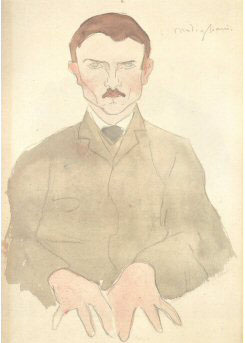 Modigliani drawing "Tables turned" Ca. 1906, Alexandre collection |
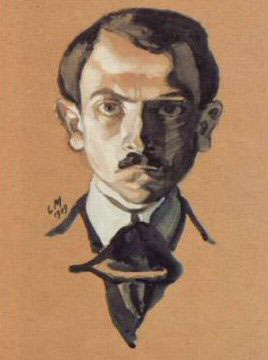 Meidner's self-portrait 1909 |
 Two Heads or the ventriloquist Ca. 1906 - 10 |
| Meidners investigation thanks to: Neil J. Stevenson Link > | ||
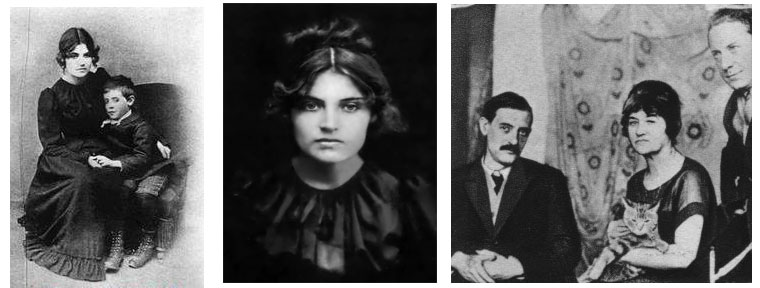 Suzanne Valadon at her glory days with son Maurice Utrillo and Andre Utter |
||
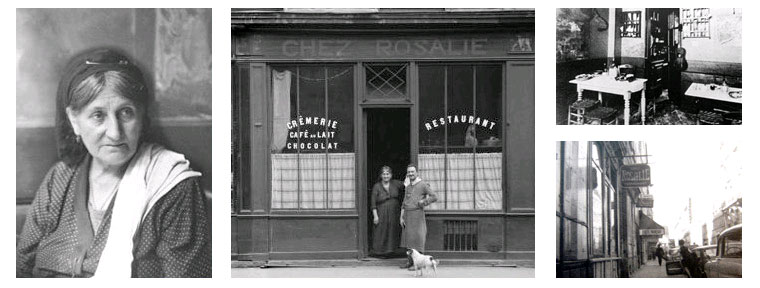 Rosalie and views of Chez Rosalie |
||
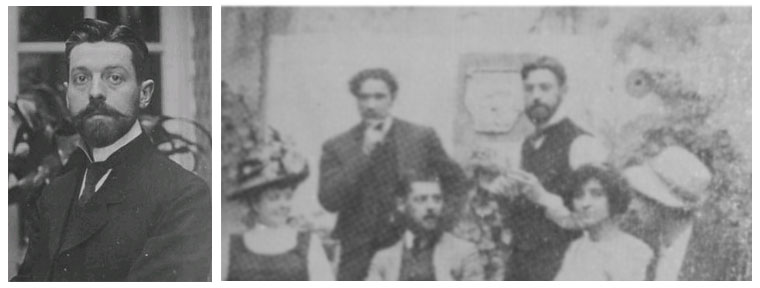 Dr. Paul Alexandre and a garden party at the Delta (Alexandre top right) |
||
| 1908 - 24 years In March he gets the opportunity to show his work at the Independants Salon, and Alexandre will acquire one, "Jewish Woman" Modigliani increases his relation with Alexandre and finally he gets into the "Delta" studios. Delta was more than a place full of ateliers, it was some sort of artists' commune created by the Alexandre brothers. He is introduced by his friends of the moment Henry Doucet and Maurice Drouard, it is a period of a terrible lack of money and constant ups and downs, very creative in terms of his painting evolution, but hard for him to live through. The relation with Alexandre is not of total trust for Modigliani, he becomes his patron/ merchant but instead of spreading his work, he seems to collect it just for him. Modigliani seems to never trust him, he never lived in the Delta, he was a very usual visitor but he never accepted the proposition to live there. He gets involved in a relationship with Maude Abrantes, an American woman of unknown past who was already married, there is not really very much data on her and the relationship, only paintings and drawings left. Some biographers mention that when she returned to America she was pregnant by Modigliani, but in November 1908 she vanished totally from the life of Modigliani and no news about the child is recorded. Three portraits of Maude from 1908: (at least 2 are undoubted portraits of Maude). His works start to gain in color probably because he has digested the influence of Cezanne. The color is not free, it gains space, but the line is the main point. He paints, but he wants to be a sculptor. |
||
| 1909 - 25 years Change of studio to "14, cite Falguiere" on the opposite side of Paris across the river, located in a new neighborhood called Montparnasse. He shares a studio with Brancusi (1876 –1957) a Romanian sculptor who will open for him the view of the sculptor as a complete artist not limited by the bi-dimensional canvas. It is a year of changes, in the first quarter he is invited to be part of the Futurist Manifest (all his fellow Italians were part at some point of the movement) and said no clearly. Thus he gained a scathing criticism from all his old friends from his Italian times (including Severini, Balla, Boccioni). Marinetti who was the "chief" of the movement never forgave Modigliani's refusal to sign the Manifesto. Even much later after the death of Modigliani when Marinetti was involved in Italian fascism he was one of the main critics of the Livournese. The influence of Brancusi is so strong that even when in Livorno for the summer he starts to work on what will be the artworks to be displayed at the "Salon des Independants" the following year. Some critics mention also the influence that Picasso´s work could have had, but Picasso was just another of all the artists of the time that were under the influence of African Art. It is a very common tendency to place Picasso as the main central figure, but he was only one more. African Art was just a fashionable discovery of those years. To say who was the first is like asking a magic crystal ball, there is no need to say who was first or when ( But a look at the roman marbles that he studied while young and to the many etruscan works can give a clue...) Anyway it is to be mentioned that while Picasso used the mask as a mask (blocking all the emotions from the subject), Modigliani used the mask as an elongation full of the emotions of the subject. He returns to Livorno for the summer (June-September) to rest and recover from Paris and his low life. |
||
| 1910 - 26 years This year was a permanent struggle to survive, his lack of money made him change studio at least 5 times. In this year, Modigliani visited at least 3 times the major exhibition of Cezanne's work hosted by the Bernheim-Jeune gallery. Even with the lack of materials, food or a roof over his head he is now a man with an objective to become a sculptor, he starts to think and develop his " temple of voluptuousness" (Temple de la Volupte) an idea that will finally never be realized. In the Salon des Indepéndants of this year six works (no sculpture) by Modigliani receive good critiques from Apollinaire, but no sales at all. Unfortunately all the historians and biographers center all this year in his drinking, drugs and scandals, mainly because of the lack of data, but it meant a year of change and new perspectives. In this year he started a relationship with the Russian Anna Ahkmatova (real name Anna Gorenko) wife of a renowned poet, who will become really important the following year. His empty stomach helped him to develop in this year what will later be a productive period that enables him among the greatest sculptors of all times. All done in just 3 years. |
||
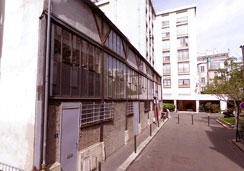 Cite Falguire studio in present times |
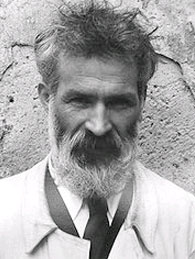 Constantin Brancusi |
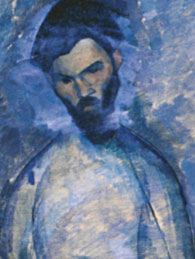 Brancusi, Ca 1910 |
 Anna Akhmatova |
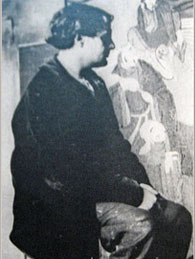 Modigliani at T. Foujita studio |
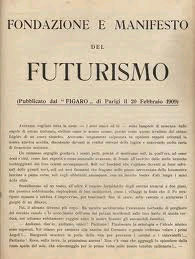 The Futurism Manifest |
| ARTIST - BECOMING AN ARTIST 1911-1914 |
||
| 1911- 27 years ( In jacques Lipchitz papers he say that Modigliani was at academie Julian with him and Cesare Sofianocopulos in that year, no other biographer mentions this, so it could be a mistake by Lipchitz in the dates) This year is dedicated to sculpture, he works ferociously at his Cite Falguiere studio on his Caryatides, which he had been sketching until perfection during the previous year (he works mainly in a limestone known as "pierre d'euvilie" and a few in wood). There is a sale, one to the painter Edward Roworth for 5 pounds. The relationship with Anna Akhmatova becomes stronger when she returns to Paris and they are commonly seen together. In March, Modigliani has the opportunity to exhibit his work at de Souza Cardoso studio (a sculptor that was in the same circle)- the results: no sales. In September he travels with his aunt Laure Garsin to a town called Yport (near Normandy.) It is not clear who paid the expenses, but it was useful to recover some health and to cool the relation with Akhmatova, which ends during the last months of the year. |
||
| 1912- 28 years This Sculpture is the center, he almost quits painting. Again in contact with Lipchitz and Epstein. This year is probably the worst in terms of cold, hunger and lack of money. His financial help that once came from his mother now changes to his brother and the income is less and less. His health got worse and that plus cold and dust in his lungs made him return to Livorno to recover. Exhibits seven sculptures in the salon d' Automne, surrounded by the biggest names of the Cubist movement. Lipchitz, who will become a figure in his life from now on, recalls seeing him working on the outside of the Cite Falguiere studio surrounded by at least 5 heads other than the one exposed at the Salon (that means at least 12 done). His relation with Jacob increases and he will be an important figure in Modi's future. Changes studio again to Montmartre and then to Boulevard Raspail where his friends will find him frozen and near starvation so they encourage him to visit his mother in Italy to rest and recover. No matter how good the critiques were, how inside the art world the artist was, or how many publications he got, this was the worst year of poverty. |
||
 4 heads by Modigliani exhibited at the 1912 Salon d'Autone along with the Cubists. |
||
| 1913- 29 years The beginning of the year saw him rejoin his old friends from earlier times: Foujita, Kisling, Utrillo, Zadkine, Rivera, etc. The English painter Augustus John visits Modigliani and buys 2 sculptures, the payment allows Modigliani to travel and rest in Italy. Previous to his trip to Livorno he stored all his sculptures and artworks with Alexandre. In April arrives in Livorno, recovery of health and re-starts sculpting but now in marble. There is a myth that later developed into the Livorno Joke that he threw the production of those months into the canal in Livorno. (the only sure thing is that there is not a single marble left...) In June, returns to Paris and stays at a new studio at 216, Boulevard Raspail, working on the Caryatides. A merchant named Cheron decided to lock him up with a model, oils, canvases and a bottle of wine, the idea ended in a total clash with Cheron according to the experts and biographers (but opposite to the art he left, we can the Cheron marriage in portraits even at 1916 and 1917, so if the had an unsolved fight how did he get portrayed so much later?). A new patron will appear in his life, Paul Guilliaume. an art dealer specialized in tribal African art. Guilliaume was fast, and during the first days of the following year Modigliani would be under his protection. |
||
| 1914- 30 years He ends direct sculpting -serious health problems because of the dust- so devotes himself only to painting. He asks his mother to quit sending money because he can now live from his paintings (a proud statement, he was on the verge of starvation.) Involved in some sort of relationship with a famous model, writer and artist known as "the queen of bohemia" (Nina Hamnett, 1890-1956). Some art historians say that he suffered strongly for having quit sculpture, but probably it was easy to return to painting, he made new efforts, had a much more developed art and a new perspective on his work. From this moment his painting will be much more than in his previous work the creation of a sculptor who paints. The relation between mass and empty space acquires a quality never previously seen in his work, he incorporates some of the tendencies of the moment such as Cubism, Futurism. They can be traced in part in his new paintings, but the paintings are in his own style and format, in the range of Tuscan perfection, classical composition and proportions. In May/June Modigliani exhibits at "Twentieth Century Art" at the Whitechapel Gallery in London. In June/July meets the eccentric English journalist, Beatrice Hastings (1879-1943). They have a stormy love affair that lasts over two years: a period where she will be the favorite model for his portraits (at least 10 verified oils and a large number of drawings). When the war breaks out (August) Modigliani is exempted from military service for health reasons. Paul Alexandre is drafted, ending all contact between them. Alexandre's relation with Modigliani ends with the war so his collection is limited to 1913, more than 400 drawings and at least 10 oils, many of the drawings will remain unknown until 1990. (Later, after the death of the artist, he will buy other works. His collection has been used by historians in their personal fights...). For the rest of his life Modigliani will devote himself almost exclusively to portraits. For the first time, things seem to be going in the right direction and in a way to achieve the recognition he deserves. |
||
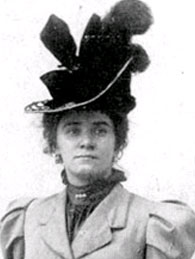 Beatrice Hastings |
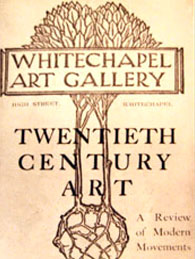 Whitechapel art gallery catalogue |
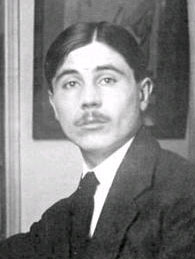 Paul Gullaume |
| SEARCH - REACHING FOR PERFECTION 1915 - 1917 |
||
| 1915- 31 years He seems to be for the first time on his way. The relation with Hastings with its ups and downs goes on, they are famous for their public fights but in the end seem to fit each other. Guilliaume is his "gallerist" and this is the time of the relation with Rivera, Picasso, Kisling, Jacob and Apollinaire. The portraits evolve to create his masterworks, his paintings show that he has solved the problem that will later create the dissolution of the Cubist movement (the use of line vs. the golden mean.) He develops his personal evolution away from Cubism to create his own style. He lives with Hastings at 13, Rue Norvins in Montmartre but in November he is at 13, Place Emile Goudeau (in the Bateau Lavoir, again) on his own. In November Guilliaume sends to America -----using Lucien Lefebvre-Foinet------ the first works by Modigliani recorded to have arrived in the States, 20 drawings, 1 pastel, 1 oil and 2 stone sculptures. He is getting attention and recognition including various mentions in articles, magazines and newspapers of the time. |
||
| 1916 - 32 years Kisling invites Modigliani to work with Leopold Zborowski. In March he exhibits a few drawings at "Noir et Blanc" in an exhibition organized by the sister of Paul Poiret. Also the same month Zaya´s Modern Gallery in New York exhibits one of his sculptures. His exhibits increase (France, Zurich, NY, Paris) he is a figure totally introduced into the art movement and one of the greatest successes of the year is the exhibition at Lyre et Palette with more than 14 paintings by him. In personal terms as his financial problems decrease he becomes more independent so his relation with Hastings changes, the fights become more extreme and crude so finally they break up in Spring. He gets involved in a relationship with Simone Thiroux, a Canadian woman who was in Paris trying to become a painter and was a close friend of Hastings. The relation will finish at the end of the year or the beginning of the new one after he discovers Jeanne Hébuterne at the Academie Colarossi in December. - Simone Thiroux a french Canadian (Ca. 1892-1921) she was a medicine student but instead of medicine she got inveolved with Modigliani and in 1917 she has a son with him named: Gérard, Modigliani never recognized the boy. The boy was given in adoption to a copuple named Sandhal, later he become a priest, he did not receive any help from the family in Livorno or his half sister Jeanne. Simone dies of TB at the Charity hospital in Paris in 1921. |
||
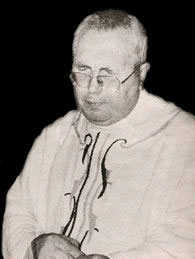 Gerard Thiroux-Villette (Modigliani) |
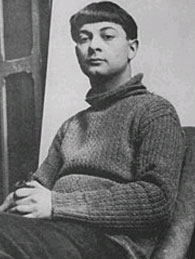 Moïse Kisling, 1916 |
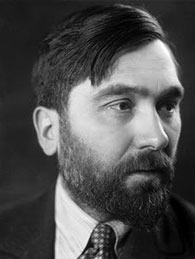 Leopold Zborowski |
| 1917 - 33 years Finally Modigliani works for Zborowski, who becomes his dealer: he produces his works in exchange for 15 francs per day ( Soutine also comes to share the studio). Probably it was not the best idea to change dealer, but the war changed everything, and Guilliaume was at that moment suffering a lot of changes so to get a new dealer was logical at some point. Maybe it became one of the reasons that affected Modi's demise and the curse that his art took in art history) The first action taken by Zborowski was to get Modigliani under his close care: Modi went to live at his house at 3, rue Joseph Bara. That is going to be the location where many of his greatest nudes will be painted (according to his regular biographers). In May he exhibits a work at the Cheron gallery (they were suposed to have a terrible fight previously, remember?) and at the Gallery Dada in Zurich and later in May he exhibits at the Paul Guilliaume gallery along with names of such importance as Cezanne, Matisse, Picasso and Derain (this can give a clear idea that he was considered as interesting an investment as the others.) In June he moves on to live with Jeanne Hébuterne (aged 19 at that moment) in an apartment at 8 Rue de la grand Chaumière (rented by Zborowski). The culmination of the year comes with the opening of the exhibition of his nudes at Berthe Weill's gallery on December 3rd. The exhibition was probably the greatest opportunity for the artist during his lifetime, but what should have been a great chance became a terrible story. The nudes where so carnal and natural (the pubic hair was the main issue) that it was closed by the authorities and the only sale was a drawing and later 5 nudes that Berthe Weill kept for herself. So the year ended with a terrible deception for the artist, but it was used by him to increase his love and commitment for his work. |
||
| GENIUS - THE PARNASSUS 1918 - 1920 |
||
| 1918 - 34 years This year is marked by the trip to the south of France and the production of another series of nudes during the first months. In March his health worsened and the lack of materials and basic foods became a serious problem. The German lines were so close to Paris that they could attack with a cannon known as "Big Bertha" (Howitzer) with the ability to hit Paris, so many people decided to escape from the city. In April Hébuterne is pregnant so they decide to move down south to be in a safe place. Matisse, Leger, all of the main names (except Picasso) are out for the moment so Zborowski decides to get his main investments out of Paris and send them to Nice, mixing a health problem with a lack of basics. Modigliani and Hébuterne arrive in Nice with the intention of selling their production to rich tourists (not many at that time...) with Foujita and Soutine. His paintings evolve with the bright colors of the south (this is a common mantra repeated by all art historians that should be changed since his palette shows the same light colors used previous to the trip and FOR GOD'S SAKE he was not from Oslo, he came from a more southerly place than Nice...) Avoiding the effect of the south or the war in his painting, this period is much more related to the peace that his relationship with Hébuterne and a regular income brings to his life, from this period the bohemian myth gets lost, it is a period of work & calm. Production is dominated by Hébuterne portraits, shop girls, children, peasants, maids and a few social portraits and also the 4 fully accepted landscapes. While in Nice he lives in the Hotel Tarelli. An armistice is signed with Germany on November 11th, and little Jeanne is born the 29th, the child is inscribed in the registry as of father unknown because Modigliani lost his wallet & papers. In December Guilliaume exhibits in his gallery 4 paintings by Modigliani and from this year until his death the number of mentions and exhibitions of his work increases rapidly, he is now on the right track and bordering on fame. He ends the year in Nice. |
||
| 1919 - 35 years Spends January in Nice waiting to receive his papers to be able to travel to Paris again and he stays there until May. Then he changes to the house of Rachel Osterlind "La Riante" in Cannes, where he meets Renoir. Two drawings by Modigliani appear next to an article by Fry in the the Burlington magazine in January. In March the works by Modigliani in the collection of Eugene Descaves are sold at auction at the Hotel Drouot in Paris. At the end of May his papers arrive so he can return to Paris (to 8 Rue de la Grand Chaumiere), Jeanne is again pregnant so she and the baby will remain in the south. He exhibits in London in July (it is not clear if he traveled there or not). The 7th of July he makes a marriage contract with Hébuterne on a common piece of paper (the real question is only between themselves, we can just make stupid speculations if that meant they were husband & wife or if it was something fabricated by others at a later stage...) The 15th of July an article on his work appears in L'Eventail: Revue de Litterature et d'Art published in Switzerland. In August he exhibits again in London at Mansard gallery (9 paintings and 50 drawings). In September again in London at Hill gallery with great success ( in sales, public and critiques.) In September there is a new article on Modigliani in the Burlington magazine and in the Fall Art and Letters reproduces another drawing. He finishes the year showing 4 paintings at the Salon d' Automne. In November Les Arts a Paris reproduces La Jolie Fille Rousse and in December there are at least another 3 publications in New York, London and Paris. His name is a must to the rest of the avant garde, his work is easy to sell and his dealer starts to take care of him being sure that he has enough material and models to paint. During this period his health gets worse and his behavior is strange and erratic, some biographers explain this using the reason of his death, tubercular meningitis, the infection has various stages and during one of the last a total transformation of conduct appears. This could explain some of the myths that later the rest of the biographers showed as examples of how stoned or drunk he was... Probably one key figure would be Hébuterne. Biographers tend to show her as a static figure, but we have to try to see her in the perspective of the life she lived: a very young woman trying to survive in the midst of a constant turmoil. Some of them even waste time on stupid speculations on the relationship (one even says that the late paintings show that the relation was near the end because he didn't portray her as "sexy" as in the first ones - for God's sake, she was 9 month pregnant!!!-) but that is just something that there is no one left to tell the truth about. |
||
| 1920 - 35 years His health worsens to a point of no return, he is found unconscious and taken to the Hospital de la Charité on Friday 23rd of January and the next day the 24th he dies of tubercular meningitis. On his easel is found the Varvarogli portrait, unfinished (don't know how is actually finished to the last detail). |
||
| Click to read more MYTH - FROM SCANDAL TO A MUST 1920 - 1950 |
||
- NO © SecretModigliani has no rights reserved, please feel free to use what you want.
- If any of the present information has a copyright whose owner wants to claim, please contact me and I will answer inmediately.